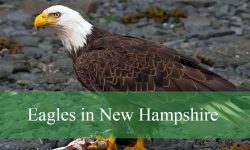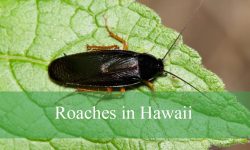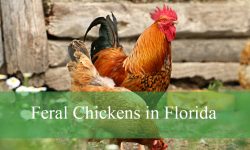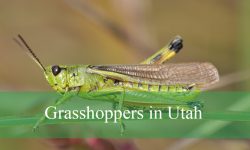I’ve always found endless joy in watching birds, especially those with brilliant yellow feathers, and to me, Alabama is truly a treasure trove for bird enthusiasts. There’s something magical about catching a glimpse of a yellow warbler flitting through the brush or hearing the song of a goldfinch on a sunny morning.
With its mix of forests, swamps, meadows, and open fields, our state is home to a surprising number of yellow birds in Alabama. Some live here all year, while others pass through during migration, adding a burst of color to our landscapes. These birds can be found in the quiet corners of backyards or deep within nature reserves.
This article will introduce you to 22 of the most stunning yellow birds in Alabama, complete with pictures and easy identification tips. Whether you’re hoping to spot them in your garden or on your next hike, you’ll find everything you need to enjoy these golden beauties even more.
Common Yellow Birds Found in Alabama
Pine Warbler
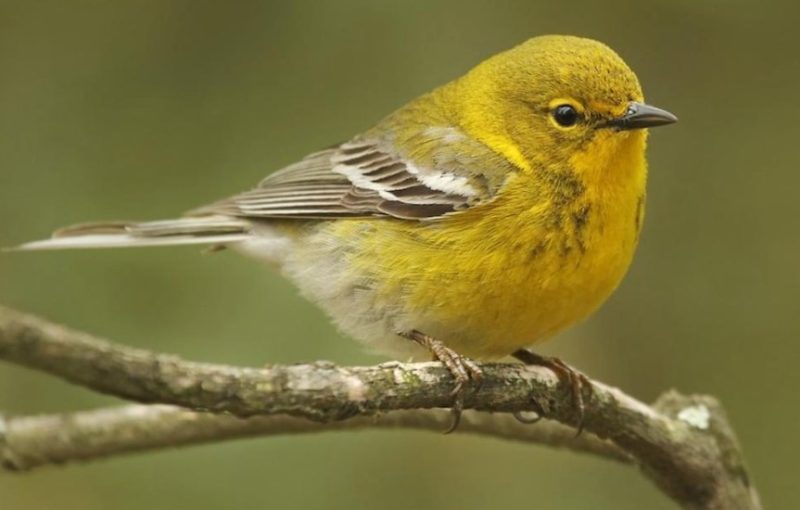
The Pine Warbler is a soft yellow-green songbird that resides year-round in Alabama, especially in pine-dominated woodlands. Males are typically dull yellow with olive-green tones on the back and faint wing bars, while females are more subdued in coloration. This species measures around 5.5 inches in length and has a sturdy bill, which is slightly heavier than other warblers.
Pine Warblers are relatively slow-moving for a warbler, often seen foraging methodically along pine branches. Unlike many warblers that migrate long distances, this bird stays within its southern range during the winter. Its trilling song, heard even in the colder months, helps identify it among quiet forests.
They primarily eat insects and spiders during the warmer months but switch to seeds—especially pine seeds and suet—in winter. Pine Warblers prefer mature pine forests, mixed woodlands, and forest edges, often venturing to feeders in Alabama backyards where suet or millet is offered.
American Goldfinch

The American Goldfinch is a familiar and vibrant bird in Alabama, recognized especially during breeding season when males show off bright yellow plumage contrasted by black wings and a black cap. Females and non-breeding males appear more muted, with olive-yellow coloring and no cap. They are small finches, about 5 inches in length, with a slender build and a short, conical bill.
This species is social and often found in flocks, chattering with high-pitched, musical calls. Though present year-round, their brilliant yellow colors in spring and summer make them far more noticeable in open areas like gardens and weedy fields. Their undulating flight and cheerful “po-ta-to-chip” calls are key field marks.
American Goldfinches primarily eat seeds—especially from thistles, sunflowers, and dandelions. They prefer open habitats such as meadows, overgrown fields, and suburban areas, and frequently visit bird feeders that offer nyjer or black-oil sunflower seeds.
White-eyed Vireo

The White-eyed Vireo is a small, energetic bird found in Alabama’s shrubby thickets and forest edges. It has a yellowish-green back, white underparts, and yellow flanks, but its most striking feature is its pale white eyes surrounded by yellow spectacles. It measures about 5 inches long and is often more heard than seen.
White-eyed Vireos are territorial and active, flitting quickly through dense foliage while giving sharp, varied calls. Their jerky movements and harsh, chattering song help distinguish them from similar species in the same habitat. These birds are commonly seen from spring through fall and may overwinter in southern Alabama.
They feed on a variety of insects, spiders, and occasionally berries. Preferred habitats include overgrown fields, woodland edges, scrubby brush, and hedgerows. They nest in dense low vegetation, making their homes well-hidden and difficult to spot.
Eastern Meadowlark
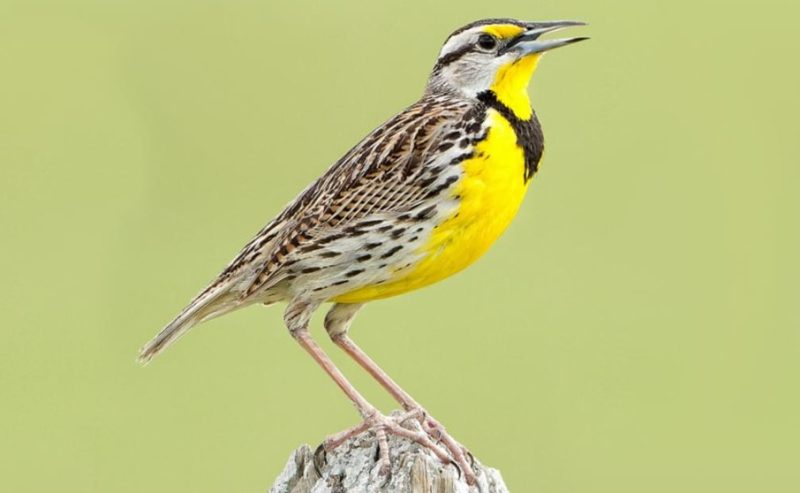
The Eastern Meadowlark is a striking bird of Alabama’s open country, known for its bright yellow breast marked with a bold black “V” shape. Its back is brown and streaked for camouflage, and it has a short tail with white outer feathers visible in flight. Measuring around 9.5 inches, it’s a relatively large songbird with a long, pointed bill.
This species prefers wide open spaces like pastures, grasslands, and hayfields, where it sings its sweet, flutelike song from fenceposts or shrubs. Meadowlarks spend most of their time walking on the ground, foraging quietly and blending into their surroundings. In Alabama, they are more common in the warmer months but may be found year-round in southern parts.
Their diet consists mainly of insects such as beetles, grasshoppers, and caterpillars, but they also eat seeds and grains. As ground nesters, Eastern Meadowlarks need tall grasses for cover and are highly sensitive to habitat loss due to mowing and urban development.
Yellow-rumped Warbler
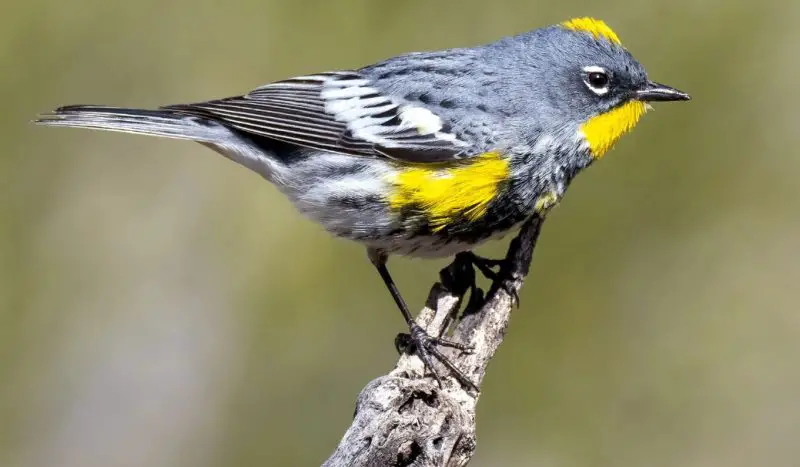
The Yellow-rumped Warbler is a common winter visitor in Alabama, recognized by its gray body, white throat, black streaks, and distinctive yellow patches on the rump, sides, and crown. Often called “butterbutts,” they are about 5.5 inches long and have a slim, agile build suited to active foraging.
Unlike many other warblers, this species is tolerant of cooler climates and can be found in Alabama’s woodlands, parks, and even suburban neighborhoods during the colder months. It’s a versatile forager, flitting between tree branches or flying out to catch insects midair with great agility.
Yellow-rumped Warblers have a varied diet, including insects, berries, and seeds. One unique trait is their ability to digest waxy berries like those of bayberry and wax myrtle, allowing them to winter farther north than most warblers. They prefer mixed woodlands, edges, and areas with fruiting shrubs in Alabama.
Orange-crowned Warbler
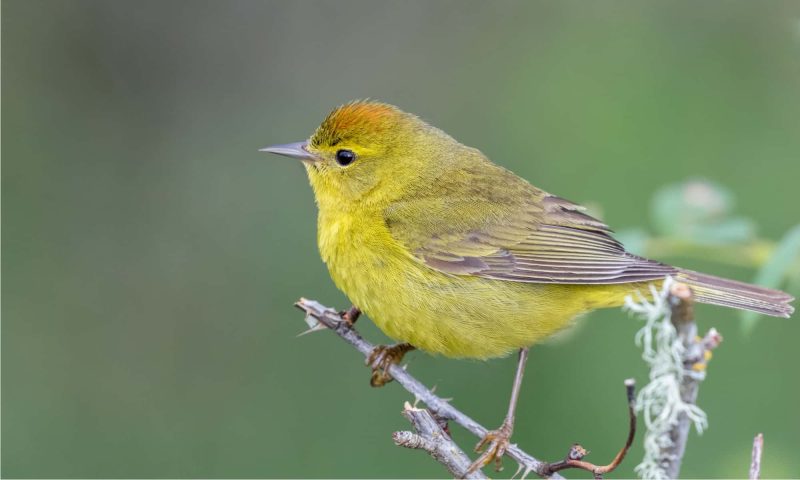
The Orange-crowned Warbler is a subtle, mostly olive-yellow warbler seen in Alabama primarily during winter migration. It is small—around 5 inches long—with faint streaking and a barely noticeable orange crown patch, often hidden from view. The bird has a slim, pointed bill and a muted appearance compared to other warblers.
These warblers are secretive and often forage low in shrubs and understory, flicking their tails while searching for insects. They are less vocal in Alabama during winter but may emit soft chips or trills while foraging. Their movement is deliberate and sneaky, making them harder to spot among foliage.
They feed on insects, caterpillars, and small spiders but will also eat nectar and berries. The Orange-crowned Warbler prefers brushy woodland edges, gardens with dense vegetation, and weedy fields during their stay in Alabama. Unlike more flamboyant warblers, they blend well into muted winter landscapes.
Common Yellowthroat

The Common Yellowthroat is a small, active warbler that’s instantly recognizable by the adult male’s bold black facial mask set against a bright yellow throat and breast. Females lack the mask and have plainer, olive-brown upperparts with yellowish undersides. This species measures about 4.5 to 5 inches long and has a compact body and a rounded tail.
In Alabama, Common Yellowthroats are frequently found in marshes, wetlands, and thick brushy areas, especially near water. They often skulk low in dense vegetation, giving a distinctive “wichity-wichity-wichity” song that helps birders locate them. Though they are more visible during the breeding season, some individuals overwinter in southern Alabama.
Their diet mainly consists of insects and spiders, which they pick from leaves and stems in dense cover. They favor cattail marshes, wet thickets, and overgrown fields and are often heard before they are seen due to their secretive nature.
Prothonotary Warbler
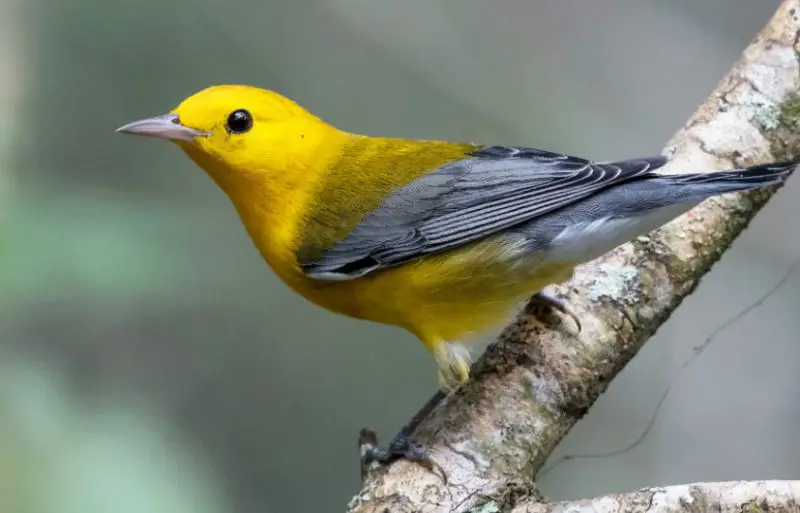
The Prothonotary Warbler is a brilliantly colored songbird with deep golden-yellow underparts, a blue-gray back, and a short tail. Males are especially vivid during the breeding season, while females are slightly duller. Measuring around 5.5 inches long, this warbler has a large head and a pointed bill.
In Alabama, Prothonotary Warblers are found in swampy forests, riverbanks, and cypress-tupelo wetlands. They prefer areas with standing water and dense tree cover, often nesting in cavities near water. Their loud, ringing “sweet-sweet-sweet” song echoes through the swamp during spring and summer.
They primarily eat insects, spiders, and other invertebrates gleaned from branches and leaves, but they will also take snails and other small prey near water. Their dependence on wetland habitats makes them a signature bird of Alabama’s bottomland hardwood forests and bayous.
Hooded Warbler
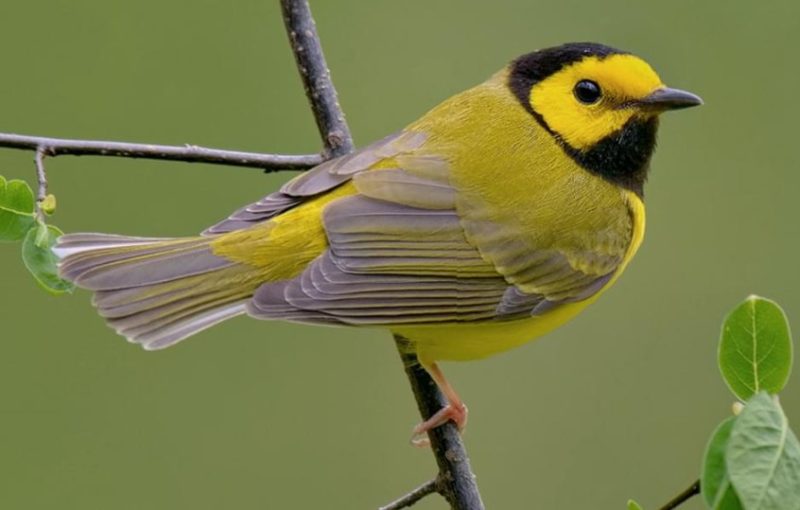
The Hooded Warbler is an eye-catching bird with bright yellow underparts and a striking black “hood” and throat patch in males. The black extends around the head, forming a bold contrast with the yellow face and breast. Females lack the full hood but may show some facial markings. This species averages about 5.1 inches long and has a rounded tail often flicked in motion.
These warblers favor low, shady deciduous forests in Alabama, especially those with thick understory. They are secretive yet vocal, delivering a loud, ringing “wheeta-wheeta-whee-tee-oh” song. Males are territorial and may be seen actively chasing rivals through the brush.
Hooded Warblers primarily feed on insects and spiders, which they catch by gleaning from foliage or through short aerial sallies. Their habitat preference includes moist woodlands with dense saplings or shrub layers, making them more common in Alabama’s southern forests and riparian zones.
Yellow-throated Warbler
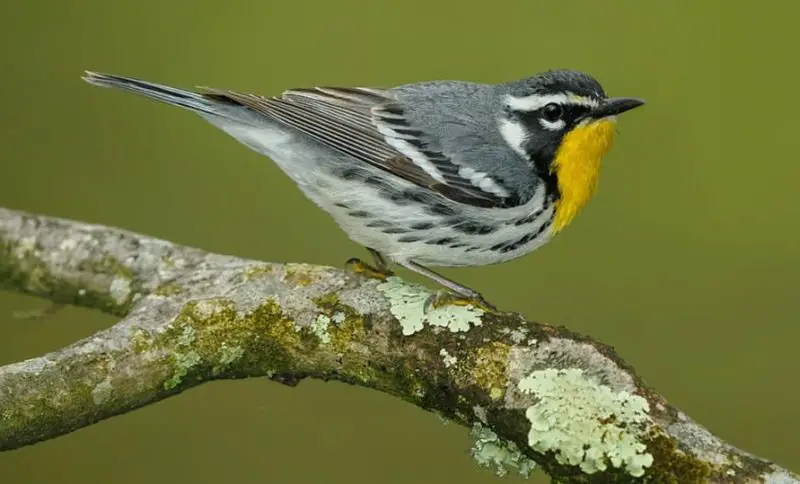
The Yellow-throated Warbler is a sleek and graceful warbler with a vivid yellow throat, crisp black and white facial markings, and a blue-gray back. It has long white eyebrows and black streaks down the sides. Measuring around 5.1 inches long, it has a long, slightly curved bill and is often seen climbing tree trunks and branches like a nuthatch.
In Alabama, this warbler is commonly found in mature pine forests, bottomland hardwoods, and cypress swamps, especially during the breeding season. It forages high in trees, using its strong legs and claws to navigate bark and foliage with agility. Its sweet, descending trill can be heard echoing through the canopy.
Their diet consists mainly of caterpillars, beetles, and other arthropods, though they may also take some fruit and nectar. Yellow-throated Warblers are strongly associated with tall trees, particularly sycamores and pines, and are best seen by scanning the upper limbs of forested areas.
Prairie Warbler
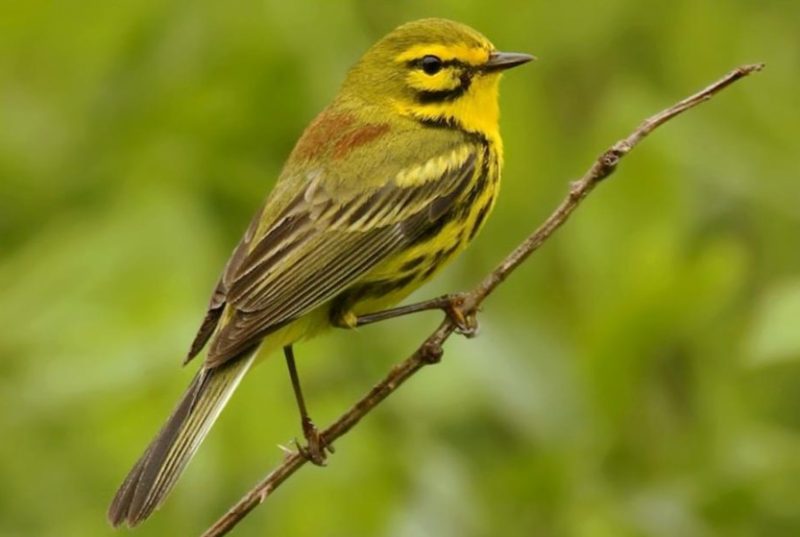
The Prairie Warbler is a small, vivid warbler with bright yellow underparts, bold black streaks along the sides, and a greenish back. It also has a distinctive black line through the eye and a slightly wagging tail. This bird measures about 4.3 to 5 inches long and appears animated and curious.
Despite its name, the Prairie Warbler prefers shrubby habitats in Alabama, including overgrown fields, pine plantations, and regenerating clearcuts. It is often found flitting among low bushes, constantly pumping its tail and singing a sweet, rising buzz that sounds like a tiny insect.
They feed primarily on small insects, spiders, and larvae, foraging by hopping through low vegetation and foliage. Their breeding range includes much of Alabama in spring and summer, particularly in open scrub or brushy edges, where their tail-wagging habit makes them easy to recognize.
Blue-winged Warbler

The Blue-winged Warbler is a striking migratory songbird with a bright yellow head and body contrasted by bluish-gray wings. It has a thin black line through the eye, a small, pointed bill, and subtle white wing bars. Measuring about 4.7 inches in length, its sleek and slender form is easy to recognize during migration seasons.
In Alabama, Blue-winged Warblers are mainly seen during spring and fall migration as they pass through on their way to and from breeding grounds farther north. They prefer shrubby fields, regenerating forests, and forest edges while stopping over. Their soft “bee-buzz” song is a signature sound in the spring, though they are generally quiet during migration.
Their diet includes insects, spiders, and small caterpillars, which they pick from leaves and twigs. While they don’t breed in most of Alabama, they may linger in dense brush and woodland edges during their brief stay in the state.
Yellow Warbler
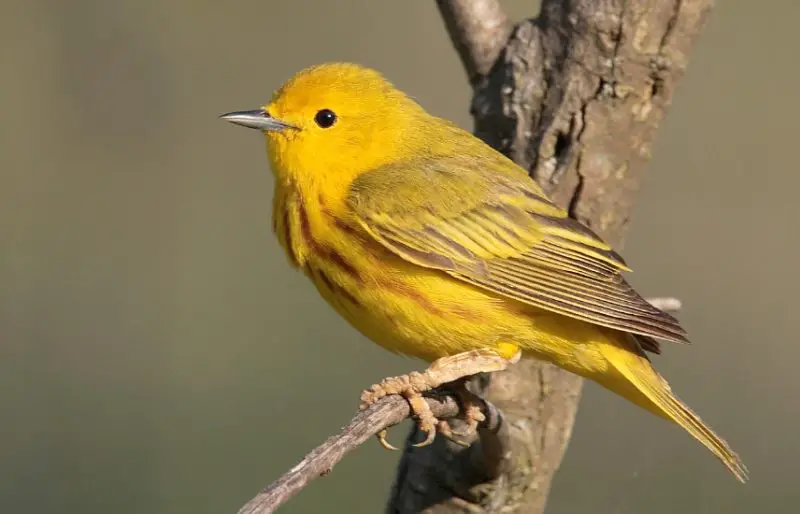
The Yellow Warbler is one of the brightest yellow birds in North America, easily recognized by its golden-yellow body and subtle reddish streaks on the chest in males. Females are similarly yellow but lack strong streaking. These small birds measure about 5 inches in length and have rounded heads with short, straight bills.
In Alabama, Yellow Warblers are typically seen near streams, wetlands, and shrubby areas during migration. They may also breed in the northern parts of the state in suitable moist thickets. They are lively and cheerful, often singing their sweet, musical “sweet-sweet-sweet, I’m-so-sweet” song from exposed perches.
They eat mostly insects, including midges, caterpillars, and beetles, which they catch among branches and leaves. Yellow Warblers prefer willow thickets, riparian corridors, and young forests, where their constant movement and bright coloring make them easy to spot during spring and fall migration.
Summer Tanager (Female)
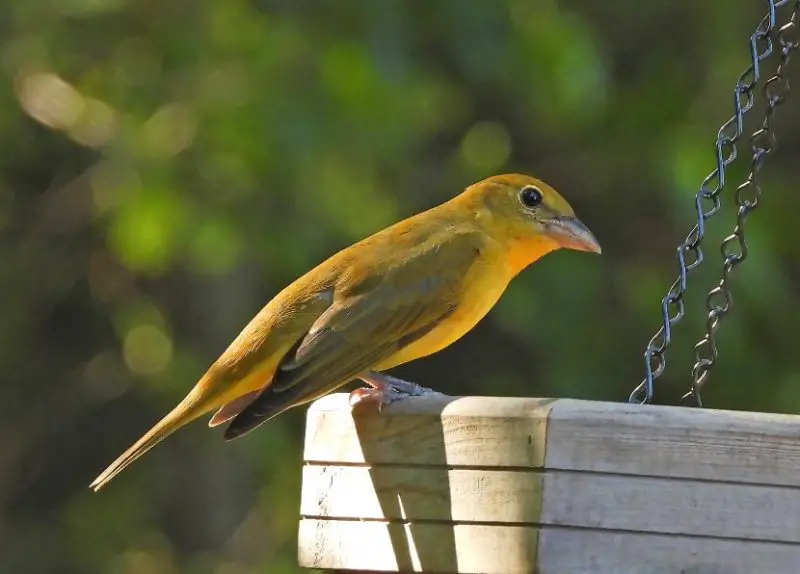
The female Summer Tanager is an attractive bird with warm olive-yellow plumage and a stout, slightly curved bill. Unlike the bright red male, the female is golden-yellow overall, often with a slight greenish wash on the back. This bird is medium-sized for a songbird, reaching about 7 inches long.
In Alabama, Summer Tanagers are fairly common in open woodlands, particularly in oak and pine forests during the summer breeding season. They are most often seen in the canopy, where they move slowly and deliberately in search of prey. Their calm demeanor contrasts with the loud, robin-like song of the male.
Females, like males, are known for catching bees and wasps midair, often removing the stingers before eating them. Their diet also includes other insects and berries. They prefer open, sunny woodlands with scattered trees, and are frequently seen near clearings, trails, or forest edges.
Orchard Oriole (Female)
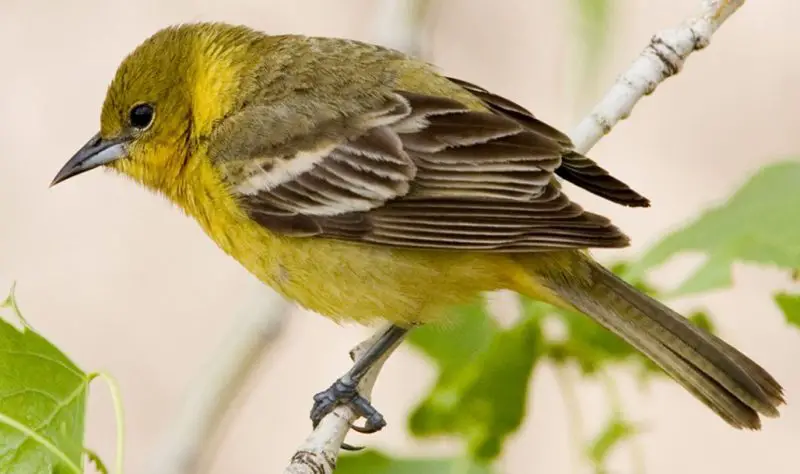
The female Orchard Oriole has a gentle appearance, with pale yellow to olive-yellow plumage, grayish wings, and a slender, slightly curved bill. She is smaller and less vividly marked than the male, measuring about 6.5 inches in length. Her coloring helps her blend into leafy environments.
In Alabama, female Orchard Orioles are most often found near riverbanks, orchards, and suburban areas with tall trees and open ground. They nest in open woodlands and groves, especially those near water. Females are responsible for building the nest and incubating the eggs while males guard the territory.
Their diet consists of insects, fruit, and nectar. They forage actively in trees and shrubs, sometimes visiting feeders for sliced fruit or jelly. Their preferred habitats include the edges of deciduous forests, orchards, and streamside woodlands, where they quietly go about their nesting duties.
Yellow-breasted Chat
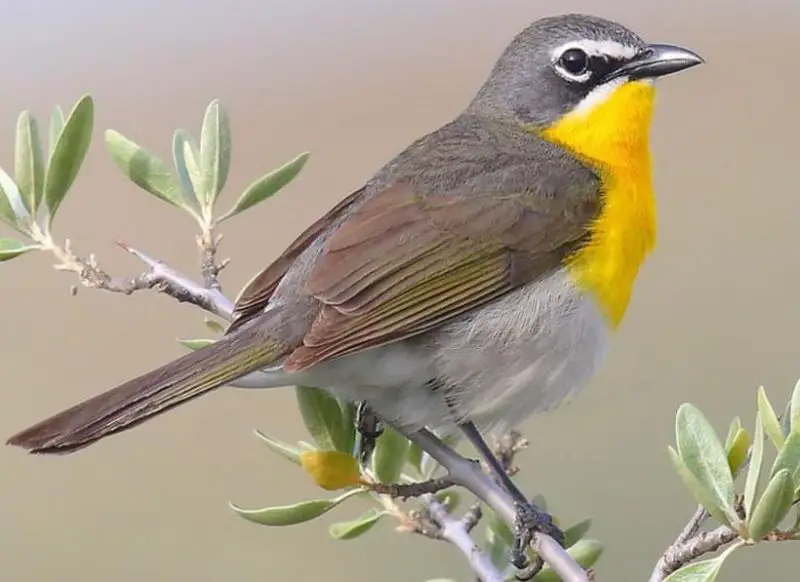
The Yellow-breasted Chat is a unique and relatively large songbird with a bright yellow chest, olive-green back, and white spectacles around the eyes. It measures about 7.5 inches long, making it the largest member of the warbler family. With a heavy bill and strong build, it often looks more like a small thrush than a typical warbler.
In Alabama, Yellow-breasted Chats are uncommon but present in dense thickets, overgrown fields, and brushy habitats, especially in southern and central parts of the state during the breeding season. They are secretive birds, often hidden in tangled vegetation, but their strange mix of whistles, cackles, and mimicry reveals their presence.
They feed primarily on insects and berries, foraging within dense foliage or near the ground. Despite their elusive behavior, they can be quite bold during breeding season, singing from exposed perches. Their need for undisturbed, brushy habitats makes them harder to find as development spreads across their range.
Cape May Warbler
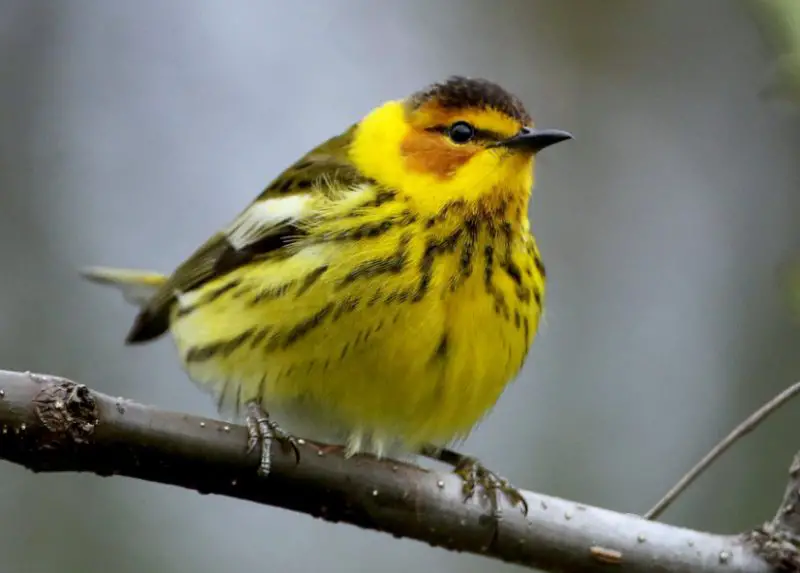
The Cape May Warbler is a small, striking warbler with a yellow chest heavily streaked with black and a chestnut cheek patch bordered by a thin black outline. The back is olive with white wing patches, and males are more brightly colored than females. This species is about 5 inches long and has a slightly curved bill adapted for feeding on insects and nectar.
In Alabama, the Cape May Warbler is primarily seen during migration in spring and fall. It travels through the state en route to and from its breeding grounds in the boreal forests of Canada. While migrating, it often stops in wooded areas, parks, and forest edges, especially where flowering trees or fruiting plants are available.
Its diet consists mostly of insects during breeding season, but in migration it readily consumes nectar and berries. In Alabama, it may feed on flowering trees like tulip poplars and apple blossoms or visit hummingbird feeders for sugar water. It prefers mid to upper tree levels while foraging.
Wilson’s Warbler
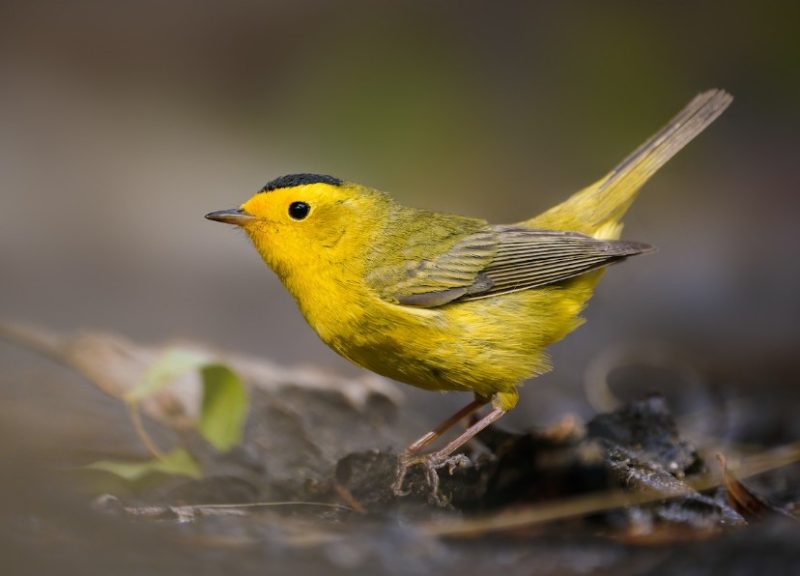
Wilson’s Warbler is a bright yellow songbird with a distinctive small black cap on its head, which is especially bold in males. The rest of its plumage is lemon-yellow below and olive-green on top. It is one of the smaller warblers, measuring about 4.7 inches in length, and has a thin bill and energetic mannerisms.
This species is a migrant in Alabama, passing through the state in spring and fall. It prefers shrubby edges, forest undergrowth, and riparian thickets during migration. Though active and flitty, Wilson’s Warbler often comes down low into brushy layers where it is easier to observe.
Its diet consists mainly of small insects and larvae, which it gleans from foliage. Because of its small size and rapid movements, it can be hard to spot unless you catch its quick flashes of yellow and black in dense vegetation. In Alabama, sightings are often brief and localized during migration windows.
Baltimore Oriole (Female)
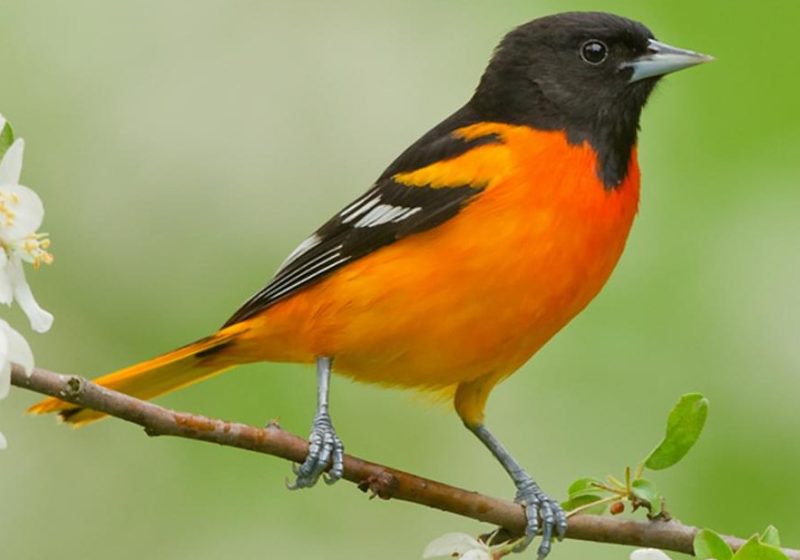
The female Baltimore Oriole is a medium-sized songbird with yellow-orange underparts, an olive-yellow back, and two pale wing bars. She lacks the brilliant black and orange coloration of the male but still stands out with her warm, glowing tones. The species measures around 7 to 8 inches long with a long, pointed bill and slender body.
In Alabama, Baltimore Orioles are migratory and may pass through during spring and fall or breed in northern parts of the state. Females are typically seen in open woodlands, river edges, and suburban parks where tall deciduous trees are present. They weave intricate hanging nests in tree branches.
Females forage for insects, fruit, and nectar. During migration, they are attracted to oranges, grape jelly, and hummingbird feeders. Their soft chattering calls and occasional sweet whistles help birders locate them in the canopy or along forest edges.
Evening Grosbeak
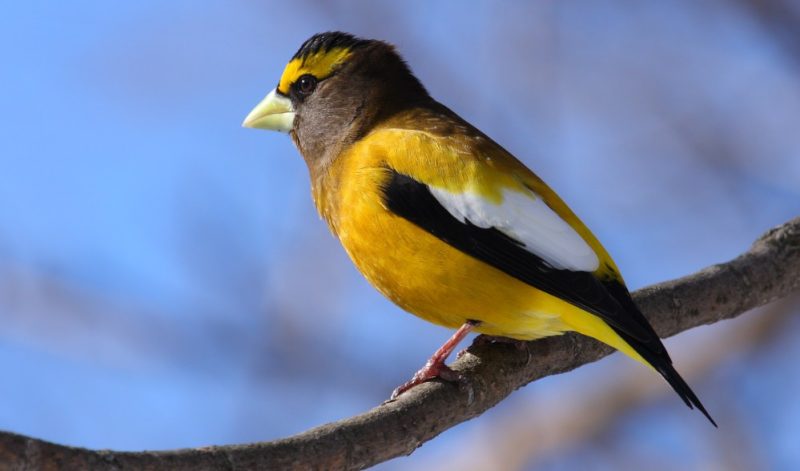
The Evening Grosbeak is a stocky, thick-billed finch with striking plumage. Males display a bold mix of yellow bodies, black wings with white patches, and heavy pale bills. Females are more muted with gray tones and yellow flanks. This large finch measures about 8 inches long and has a powerful presence at feeders.
In Alabama, the Evening Grosbeak is a rare winter visitor during irruption years, when food scarcity up north drives the species farther south than usual. These birds may show up unpredictably at feeders, parks, or forest edges where seeds are abundant.
They primarily feed on seeds, berries, and insects. In Alabama, they may visit sunflower feeders or forage in maple and boxelder trees. Because of their rarity in the region, any sighting of Evening Grosbeaks is considered notable and exciting among birdwatchers.
Western Kingbird
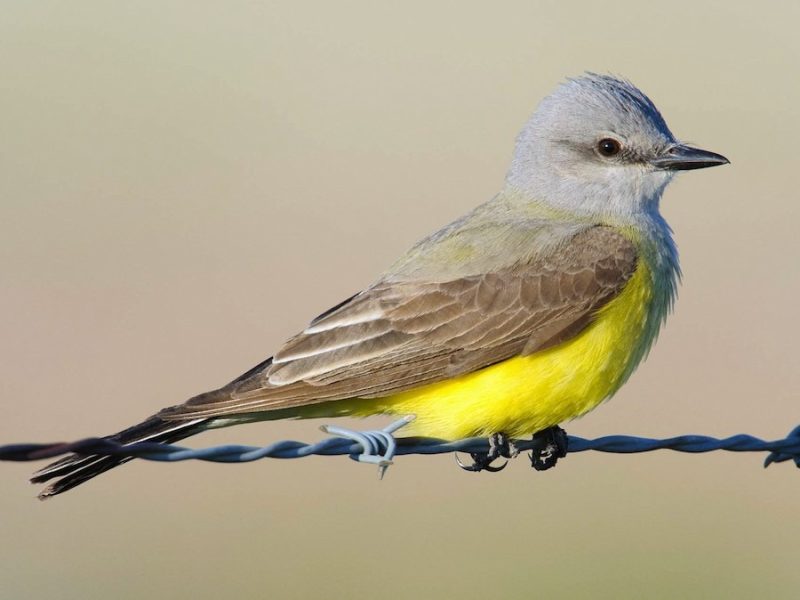
The Western Kingbird is a medium-sized flycatcher with a gray head, pale chest, and vibrant yellow belly. It has a straight black bill, long tail with white outer edges, and a bold posture when perched. It measures around 8.5 inches in length and often perches prominently in open habitats.
Although not common in Alabama, Western Kingbirds occasionally appear during migration or vagrancy events, especially in the western and central parts of the state. They are more common west of the Mississippi, but open farmland, roadside fences, and pastures in Alabama can occasionally host these rare visitors.
They feed primarily on flying insects, often catching them midair in acrobatic sallies. They may also eat berries and small fruits. Their bold, upright posture and aggressive territorial behavior make them stand out when they do occur in the region.
Yellow-headed Blackbird
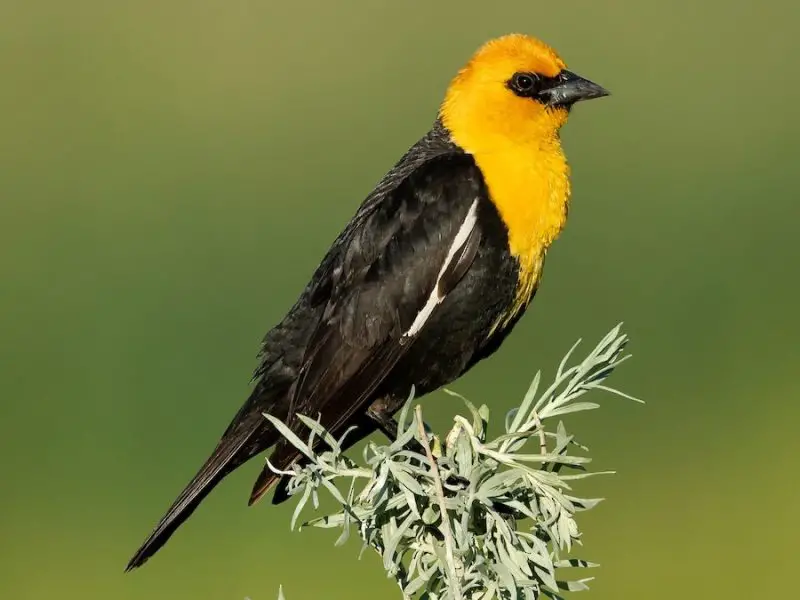
The Yellow-headed Blackbird is a large and striking bird, with males showing bright yellow heads and chests, contrasting with jet-black bodies and white wing patches. Females are duller, with brown bodies and muted yellow on the head and throat. These birds are about 9 to 10 inches long and are larger than most blackbirds.
In Alabama, the Yellow-headed Blackbird is a rare migrant or accidental visitor, most often spotted in large mixed flocks with Red-winged Blackbirds in open wetlands or agricultural areas. Sightings are sporadic and typically occur during migration or winter.
Their diet includes seeds, grains, and insects, often foraged in fields, marshes, or feedlots. Males are known for their harsh, mechanical songs and dominant displays during breeding season—although those behaviors are rarely seen in Alabama due to their limited presence. When found, they’re usually in open, wet habitats like marshes or along lake edges.
Best Time and Places to See Yellow Birds in Alabama
The best time to observe yellow birds in Alabama is during spring and fall migration, typically from March to May and again from late August to October. During these seasons, a variety of warblers—including Cape May, Wilson’s, and Yellow Warblers—pass through the state in vibrant breeding plumage, making them easier to identify. Resident species such as the Pine Warbler, American Goldfinch, and Common Yellowthroat are visible year-round, with increased activity during the spring and summer breeding season. Early mornings, especially on calm and clear days, offer the best opportunities to hear and spot these birds as they forage and sing.
Yellow birds favor specific habitats depending on their species. Wetlands, such as Wheeler National Wildlife Refuge in north Alabama and the Mobile-Tensaw Delta in the south, attract Common Yellowthroats, Prothonotary Warblers, and Yellow-breasted Chats. Riparian woodlands and swampy forests are prime spots for Hooded Warblers, Yellow-throated Warblers, and Summer Tanagers. For shrubby fields and brushy edges, look to places like Oak Mountain State Park or the Tuskegee National Forest, which support Prairie Warblers and Blue-winged Warblers during migration.
Urban and suburban areas with well-maintained backyards and native plantings can also be rewarding, especially for American Goldfinches, Orchard Orioles, and Baltimore Orioles. Providing feeders with nyjer seed, sliced fruit, or sugar water can attract some of these species, particularly during their spring movements. No matter the region, Alabama’s diverse landscapes make it one of the Southeast’s most rewarding states for spotting yellow-plumaged songbirds throughout the year.


